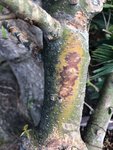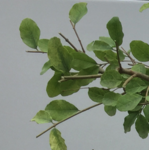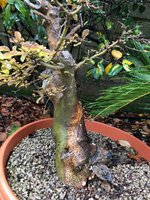It definitely looks like something happened in that light tan dot - there is a crack in the bark. And it is clear that the cambium is dying around it. I don't know if it is because of something from the plant or animal kingdom, but it seems pretty clear that if one just sits and looks at it, it will, likely just get bigger, just as you fear.
So, suppose you carve the bark away, lifting off all that area, including the yellow boundary and see what you can figure out. And disinfect your knife and the area(s) where you handled this chunk of bark with 70% isopropyl alcohol (a household bleach solution works just as well but will etch your tools).
If you don't see eggs or some other sign of bugs, your worries that it is fungal would seem appropriate. No spray will cure a fungal infection because the hyphae are in the tissue of the tree and sprays basically don't penetrate - only a systemic fungicide can. While you may want to do that for the long term, I suggest that you consider 'cauterizing' the area. That is lightly burn the entire area, including the live bark boundary with a butane torch. This should kill any hyphae and forms some protective compounds. Again, only to the point of browning or a slight char. It has worked for me combating cankers in Japanese maples.






